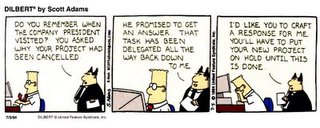Should I start my own venture? This is one question we often ask ourselves at some or other points in our career. Some say that entrepreneurship has got nothing to do with one educational background but it’s more about instinct and acumen. Dave Pollard talks about this in his post on Ten Reasons Young People Are Afraid to Start Their Own Business .For those of who plan to have any venture in the near future it’s a must read guide…
1. Don't Have the Skills: "I wouldn't know where to start. I took entrepreneurship in college, but it was all about understanding financial statements and types of loans. I've never even spoken to a successful entrepreneur."
1. Don't Have the Skills: "I wouldn't know where to start. I took entrepreneurship in college, but it was all about understanding financial statements and types of loans. I've never even spoken to a successful entrepreneur."
2. Don't Have the Self-Confidence: It needn't be intimidating. This is mostly fear of the unknown, and the lingering mythology of entrepreneurship that is perpetuated, alas, because so many entrepreneurs keep making the same avoidable mistakes over and over.
3. Don't Have the Ideas: Perception, not conception, is the key to entrepreneurial success: Paying attention is far more important than creativity. It's all about finding a need and filling it, not coming up with an idea and then trying to find someone who might buy it.
4. Don't Have the Money: If you can fill an unmet need, there are several ways to finance the business organically; drawing on the interest and investment capital of suppliers, potential customers and business partners, and people you know who are always looking for a way of getting a better return than they can get in the bank.
5. The Deck's Stacked Against Entrepreneurs: the key to successful entrepreneurship is to find a need that is not immediately or obviously big enough or profitable enough to attract the attention of the dominant players in your industry. This is what Clay Christensen calls Disruptive Innovation, and entrepreneurs have the advantage of agility (and not having shareholders demanding seven digit revenues from any new offering) that makes them more adept that doing this than large corporations. This is a great equalizer.
6. Couldn't Handle the Failure: A survey a few years ago by Inc. Magazine found that only one factor correlated strongly with entrepreneurial success: A previous entrepreneurial failure. This is how you learn. If you avoid over-committing and learn how to "fail fast and early", you can have the resilience to be a 'serial entrepreneur', and be comfortable with the fact that no entrepreneur succeeds in every undertaking.
7. Don't Know the Process: "I took some MBA courses, and they didn't teach me anything about how to start or run your own business. Where do you learn this?" This is the principal function that The Natural Enterprise will serve.
8. Don't Have the Time: "I'm working two jobs now just to make ends meet. If there were more hours in the week I'd take a third one. How could I ever find the time to start my own business?" The biggest time-consumer in starting a successful Natural Enterprise is the up-front research. But that research can be done while you're doing other things you're already committed to.
9. Couldn't Handle the Stress: Entrepreneurs who live with that much daily stress (and there are a lot of them) are, in my experience, mostly running ill-conceived business. I know many entrepreneurs who absolutely love their work, are beholden to no one, and are doing so well they can afford to turn away lots of business (especially from aggravating customers) because they'd rather pursue leisure activities than work long hours. If your business truly taps an unmet need, you'll have good customers, and very little business stress.
10. Couldn't Handle the Loneliness: "The entrepreneurs I know are the loneliest people in the world. They work incredible hours and have no time for anything else. They have to learn how to do everything themselves, because they can't afford experts and consultants." The biggest mistake a lot of people make in starting their own business is trying to do it all themselves. One of the most critical decisions in creating a Natural Enterprise is finding business partners who have skills and knowledge that complement (without overlapping) your own, who have the same commitment to the idea that you do, and who you love working with. Get that right, and how could you possibly be lonely?


